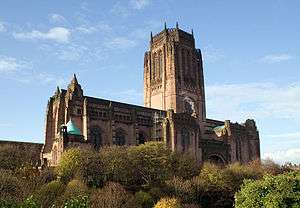Museum of Liverpool
.jpg) | |
| Established | 2011 |
|---|---|
| Location | Pier Head, Liverpool, England, United Kingdom |
| Coordinates | 53°24′11″N 2°59′44″W / 53.4031°N 2.9956°W |
| Website | http://www.liverpoolmuseums.org.uk/mol/ |
The Museum of Liverpool in Liverpool, England, is the newest addition to the National Museums Liverpool group having opened in 2011 replacing the former Museum of Liverpool Life. National Museums Liverpool intention is for the new venue to tell the story of Liverpool and its people, and reflect the city’s global significance. The museum is housed in a new purpose-built building on the Mann Island site at the Pier Head.
The museum, designed by architects 3XN and engineers Buro Happold, was expected to cost £72 million and provide 8,000 square metres of exhibition space, housing more than 6,000 objects.[1] There are also plans to have flexible spaces that regularly change to enable National Museums Liverpool to show more of their collections.
It was opened to the public on 19 June 2011.[2] The museum will be closed for two months for essential works in January & February 2017.[3]
Exhibitions
Exhibits from the entirety of National Museums Liverpool's collections are used for the Museum of Liverpool's displays. They tell the story of the city through items from collections of costume and decorative art, entomological and botanical collections and objects representing social and urban history, as well as oral testimonies, archaeological material and photographic archives.[4]
On 27 February 2007, steam locomotive Lion, star of the film The Titfield Thunderbolt, was moved by road from Manchester to Liverpool after being on loan to Manchester while the new museum was under construction. Some conservation work took place prior to it taking pride of place in the new museum.[5]
From September to November 2012 the museum staged the Liverpool Love exhibition, in which well known personalities such as Yoko Ono, Sir Peter Blake and Noel Fielding celebrated the city of Liverpool.[6]
Core themes

The Museum displays are divided into four main themes: The Great Port, Global City, People’s Republic, and Wondrous Place, located in four large gallery spaces. On the ground floor, displays look at the city's urban and technological evolution, both local and national, including the Industrial Revolution and the changes in the British Empire, and how these changes have impacted the city's economic development. The upper floor looks at Liverpool's particular and strong identity through examining the social history of the city, from settlement in the area from Neolithic times to the present day, migration, and the various communities and cultures which contribute to the city's diversity.[4]
The Museum also features: Little Liverpool, a gallery for children under six; History Detectives, an interactive archaeology and history resource centre; a 180-seat theatre for community and audio-visual performances and meeting facilities; .[4]
References
- ↑ "Museum of Liverpool facts and figures". National Museums Liverpool. Retrieved 2010-02-25.
- ↑ "Museum of Liverpool opens to the public".
- ↑ Jones, Catherine. "Museum of Liverpool to close for 'essential work'". Retrieved 2016-11-14.
- 1 2 3 "Themes and displays in the new museum". National Museums Liverpool. Retrieved 2010-02-25.
- ↑ "Train leaves city - by road!". Manchester Evening News. 27 February 2007. Retrieved 2007-02-28.
- ↑ "Noel Fielding, Yoko Ono and other artists show Liverpool Love" (Slideshow). BBC News. 28 September 2012. Retrieved 2014-04-23.
External links
| Wikimedia Commons has media related to Museum of Liverpool. |


